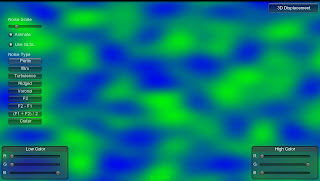I borrowed a MacBook from one of my friends and installed Unity on it. That allowed me to quickly port all of the noise functions to GLSL and ensure they all worked on Mac. However, I was still having issues with the noise functions on my Android devices. Unity on Android is actually incredibly unhelpful in this regard. It doesn't report any errors or anything. The shader simply fails and runs a fallback shader.
I decided to create a WebGL test page using the same GLSL code since WebGL uses OpenGL ES 2.0 (the same as mobile devices). I quickly found out (and remembered, as I've posted about this in the past) that OpenGL ES doesn't allow variables in for loop expressions. It must be a constant expression (i.e. loop a fixed number of times). I made a mobile port of my GLSL noise that forced all summation functions (fBm, Turbulence, and Ridged) to loop 8 times. Even though this changed allowed the code to work properly in WebGL, it was still not working on Android.
I then took a different direction and tried writing a straight Java test app for Android. I found out there is a major bug where Android won't report the shader compilation errors. It just gives you an empty string. Not very helpful. I managed to get the shader to compile, but I ran into more OpenGL issues due to mismatched vertex attributes. I cast aside the example in frustration.
Someone who purchased a copy of GPU Noise let me know that Xcode on Mac actually reports shader compilation errors, so I begged a coworker of mine who has a Mac, Unity, and an iOS developer license to give it a try. As soon as he deployed it to his iPad, we saw the error that has been eluding me this entire time. There was a "Uniform precision mismatch" with some of my variables. I did some investigation and found out that vertex shaders in GLSL default to high precision while pixel shaders default to medium. I hard coded my vertex shaders to use medium precision and now almost all of my functions work on Android! I say almost because all of the Voronoi 3D Displacement functions seem to peg out the CPU (as before) and cause the device to freeze and crash. I think they're just too resource intensive to use on current mobile devices (they work on Windows and Mac just fine). At least the 2D Animated Voronoi functions all work on Android.
Related to an earlier post, I still need to figure out why a Tegra 3 sucks so much. It's not just speed, but also the rendering quality. Here are a few comparisons for example.
EVO 3D
Transformer Prime
EVO 3D
Transformer Prime
As you can see, the Transformer Prime looks horrendous! I'm not sure what's causing such terrible visual artifacts. Hopefully someone online has an idea.
Until next time...



